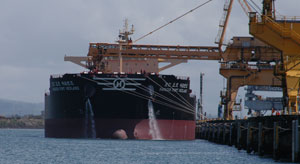Vessel owners operating under International Maritime Organization regulations were given an additional two years in July to comply with Ballast Water Management Convention requirements. However, vessels operating in U.S. waters still must comply with Coast Guard regulations stricter than the IMO’s protocol.
At a meeting of the IMO’s Marine Environment Protection Committee (MEPC), the group approved a new implementation schedule for meeting ballast water management (BWM) requirements only two months before the convention was supposed to enter into force in September. The new deadline extends the compliance deadline for treating ballast water discharge for about 40,000 existing ships.
Under the new plan, compliance is required at the first or second International Oil Pollution Prevention (IOPP) renewal survey after September 2017, subject to certain conditions. Existing vessels will be allowed to operate without retrofitting a BWM system through 2024, depending on the individual vessel’s IOPP survey. This measure extends the deadline by two years. Ships constructed after Sept. 8, 2017, must be compliant when delivered.
However, as the United States is not a signatory to the Ballast Water Management Convention, the Coast Guard issued a reminder that commercial vessels with ballast tanks operating in U.S. waters must comply with U.S. standards. Coast Guard investigations into ballast water discharges revealed that some vessel owners had received statements of compliance from the IMO and mistakenly believed the certificates also applied to operating in U.S. waters.
The delay in the IMO timeline had been sought by flag states including Brazil, the Cook Islands, India, Liberia, Norway and the United Kingdom, along with industry groups Intertanko, Intercargo and the International Council of Shipping.
“If this pragmatic proposal is agreed, this would allow shipping companies to identify and invest in far more robust technology to the benefit of the marine environment,” said Peter Hinchliffe, secretary-general of the International Chamber of Shipping (ICS).
One factor for those seeking the delay was the more stringent type-approval standards adopted by the IMO in 2016 that will be included in the pending Code for Approval of Ballast Water Management Systems. The ICS noted that these more environmentally robust standards will not become mandatory for new system approvals until October 2018. Vessel owners faced the possibility of installing expensive equipment now that may not be compliant in the future.
Another reason industry groups sought the delay is a reported shortage of ballast water management systems that have been type approved by their respective administrations, although 69 systems have been approved by the IMO so far. The Coast Guard had issued type approvals to four systems as of June.
BWM retrofits on existing fleets present challenges due to restrictions on electrical power and piping, and footprint requirements. Intercargo cited challenges for the global bulk carrier fleet, the largest single sector based on deadweight tonnage, much of which utilizes a gravity discharge system for topside ballast water tanks.
While differences between IMO and U.S. requirements mean there is no single globally recognized performance standard for BWM systems, experts say U.S. regulations will set the standard for a large portion of the global fleet.
“For any newbuilds or vessels being rechartered, there is the consideration that even if they don’t go to the U.S. today, they might in the future,” said Ian Stentiford, global vice president for Evoqua Water Technologies. “So you have to look at the impact on the value of the vessel if it can’t go into U.S. water for a period of time.”
In March, the Coast Guard issued a marine safety information bulletin that affects the application process for extensions to install BWM systems. Extensions will no longer be linked to the vessel’s dry-docking schedule and also will be considered differently depending on three age categories.
For vessels with compliance dates through Dec. 31, 2018, the Coast Guard requires owners to submit a plan and timeline for meeting the requirements.
The process includes a review of correspondence with manufacturers and/or shipyards to show what an owner is doing to comply. For example, if one of the type-approved systems is suitable but not available to meet the vessel’s dry-dock schedule, the Coast Guard may grant an 18-month extension.
“Any extension request will be bolstered if the vessel operator demonstrates an understanding of how to match the operating profile of their vessel to the operating profile of a CG type-approved BWMS,” Rear Adm. Paul Thomas wrote in the Coast Guard’s Maritime Commons blog.
For vessels with compliance dates between Jan. 1, 2019 and Dec. 31, 2020, the Coast Guard may not accept justification for non-installation. The Coast Guard will review these situations 18 months before the compliance date. The Coast Guard advised the MEPC that vessels with a compliance date after Jan. 1, 2021, should not expect to receive an extension.

